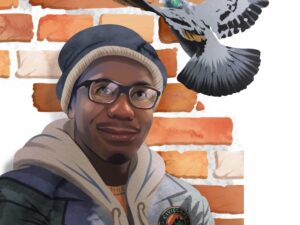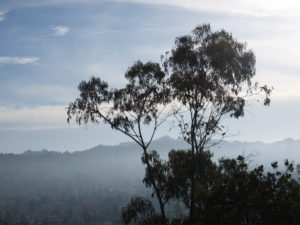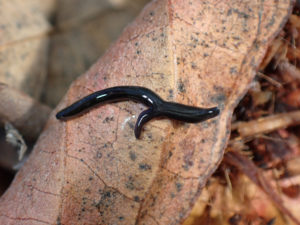Jake Sigg handed me his mattock. “Well, I suppose I should clarify,” Sigg said. “It’s a hand mattock.” A hybrid between a pickaxe and a hoe, the mattock was to be my tool of destruction. Or, on this particular day in early February, restoration. Sigg and I were standing in a creek bed, just north of the Laguna Honda Reservoir, at the base of Mt. Sutro’s western slope, in the center of the San Francisco Peninsula. Sunlight streamed through a canopy of Monterey pine and coast live oak. Down in the creek, the air was cool and moist.
Sigg wore a rough brown Carhartt work shirt and black dickies. His leather boots were caked with dirt. A brown, brimmed mesh hat, faded from years of sunlight and sweat, sat on his head. His attention had initially been caught by a healthy mass of giant vetch, a native plant with long, pea-like tendrils and deep red flowers. But now he continued up the creek bed, pointing out vivid green bunches of watercress, light pink wild cucumber, dark pink California bee plant, hot pink current, violet veronica, willows, rushes, ladyfern. Eventually, he stopped at a large herb that had shiny, dark green leaves with psychedelic purple splotches. He planted his feet on either side of the herb, wrapping its shoots and stems in his hands as if he was preparing for a game of tug of war with the earth. “You need to get the whole taproot on this hemlock,” he said.
Lifting up from a squat, Sigg pulled what looked like a large white carrot out of the ground. “All parts of it are deadly poisonous,” he said, dropping it on the trail. “It’s what they fed Socrates.”
The Laguna Honda Reservoir was once a natural lake, but it was drunk dry and concreted. In 1865, the Spring Valley Water Works built a redwood pipe 13 miles long to fill the reservoir with water from San Mateo County, south of San Francisco, but the great quake of 1906 destroyed the pipe. The reservoir—which serves as an emergency backup water supply—and its surrounding natural areas are now owned by the San Francisco Public Utilities Commission. Just north of the reservoir, along 7th Avenue, a trail leads up the hill to a clearing. For years, a group of homeless established a camp in the clearing. They dammed a creek and built their own reservoir, four feet deep, which they used to water a small orchard of plum trees. Eventually, the public utilities commission called in the police to remove the homeless. The small reservoir was filled with dirt. The plum trees died.
Weeds prefer disturbed soil. When the police forced the homeless out of the park, leaving behind a freshly trampled hillside, the poison hemlock forced itself in. So did the panic veldtgrass, the yellow oxalis, and the Himalayan blackberry, which began to choke what was left of the natural stream that flowed in the creek. To get rid of the Himalayan blackberry, the public utilities commission brought in a herd of goats, but all they did was eat the leaves. Frustrated with the goats, the commission gave the job to the Recreation and Parks Department, which brought in Sigg.
“I imagine being with Jake is, in many ways, like being with John Muir. We have a living legend amongst us. That’s how I see him.”
Now, the all but forgotten strip of land, hanging on to the hillside between the roadway and a housing development, is one of more than half a dozen parks and natural areas that Sigg and several Recreation and Parks employees quietly tend like a garden, cultivating the native plants and weeding the invasive non-natives.
Sigg climbed out of the creek and moved back up the trail. He told me to look to my right. Several large oaks shaded the colorful creekbed like umbrellas. As we turned a corner at the top, Sigg stopped and held his arms out wide. “Tada!” he said. “What a mess. This used to look like the hillside behind us, where all the diversity is. What diversity do you see here?”
In the late 1800s, Adolph Sutro—the engineer, philanthropist, and mayor of San Francisco for whom Mount Sutro is named—planted thousands of Tasmanian blue gum eucalyptus on the hill, and the slope to the left of the trail was dominated by them. Their huge trunks, mottled brown and gray, looked like concrete pylons. A wall of dark green English ivy covered the forest floor and clung to their branches, rising up from the understory like thick fog.
Sigg dropped his pack. “We’ll work here for the day,” he said.
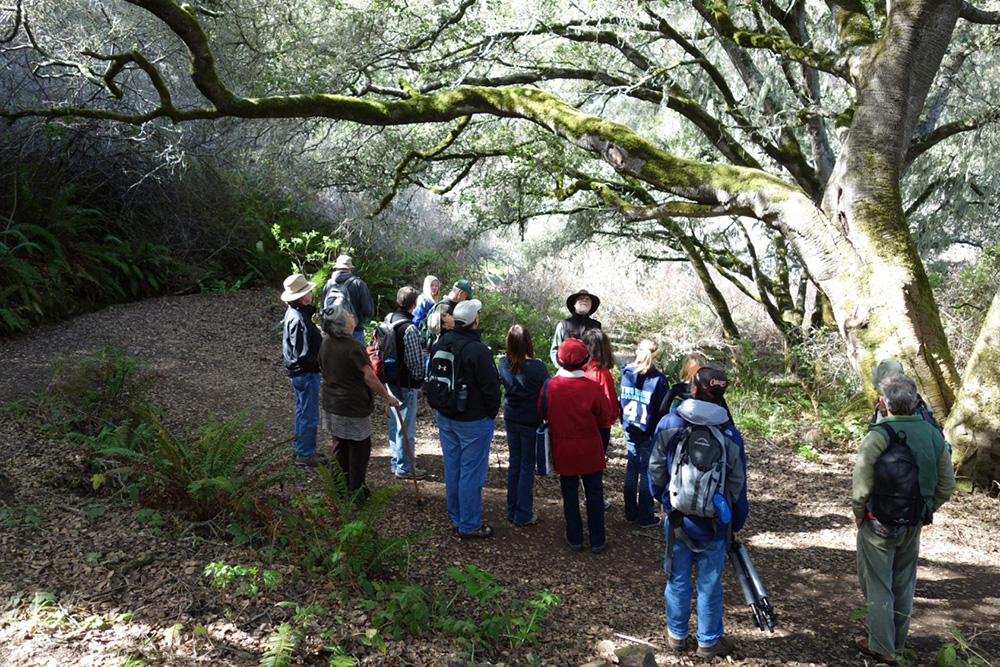
Sigg, who is ninety-one, is the staunchest public defender of native plants and, quite possibly, the most famous living naturalist in Northern California. He is a founding member of both the California Invasive Plant Council and the California Native Plant Society, where for many years he was chair of the “invasive exotics committee.” In 1997, the society named Sigg a “fellow,” the highest recognition it awards its members. Each year, Cal-IPC gives out the “Jake Sigg award for Vision and Dedicated Service.” He has been called the “doyen of San Francisco’s native plant movement.”
“I imagine being with Jake is, in many ways, like being with John Muir,” said Christopher Campbell, the chief natural resource specialist for the San Francisco Recreation and Parks Department and Sigg’s friend. “We have a living legend amongst us. That’s how I see him.”
Sigg has spent more time pulling weeds in San Francisco’s parks and natural areas than his decades working as a city gardener, but after a lifetime in the soil, his point of view in the debate over native plants is at risk of being uprooted by society’s evolving ideas of wilderness and nature. To some, Sigg is the public face of a conservation movement gone sour. They argue his dread of non-native plants is inseparable from his politics, which are anti-immigration. He has been called, among other things, a “plant nazi.”
“Nativism in the natural world is, at the moment, the conventional wisdom,” said Mary McAllister, a blogger who spent 20 years opposing Bay Area tree-removal projects and one of Sigg’s frequent antagonists. “And Jake has been the leader of the native plant movement in the San Francisco Bay Area for 30 years. The people who subscribe to that philosophy look up to him. They’re true believers and he is their guru.”
Under the shadow of the eucalyptus trees, Sigg showed me the best way to weed with the mattock. He grabbed a single oxalis near its base—“by the scruff of its neck,” he said—and pushed the pick into the dirt. With a single fluid motion, he twisted the oxalis counterclockwise and leveraged the pick like a crowbar. The weed popped out of the ground with ease and Sigg threw it into the trail. We went on weeding oxalis like that for more than an hour.
By the time we had made a noticeable dent, it was afternoon and the sun had moved from behind the eucalyptus. Sigg popped up from his gardener’s crouch, grabbed an orange from his bag, and got comfortable against the trunk of a dead plum. He picked up his mattock and poked at a blade of grass growing out of a knot in the tree, then he used it to scratch his chin. I ripped a clump of oxalis out of the ground and shook away the bits of dirt. “Hey! You got a good part of the taproot,” Sigg told me. “Throw it in the trail and it’ll die by sunset.” I tossed the oxalis aside to desiccate in the dry and baking California air.
“Jake has been the leader of the native plant movement in the San Francisco Bay Area for 30 years. The people who subscribe to that philosophy look up to him. They’re true believers and he is their guru.”
It was researchers at Stanford University—just 30 miles south of Mount Sutro, as the crow flies—who helped to bring the importance of native plants, as Sigg understands it today, out of ideological metaphor and into the realm of science.
In 1964, Paul Ehrlich and Peter Raven, professors of entomology and botany, respectively, at Stanford University, published their paper, “Butterflies and Plants: A Study in Coevolution.” In it, they gave the most detailed account up to that point of butterfly genera (multiple species make a genus, multiple genera make a family, and so on) and the different plants they could stomach. Diet, they argued, was the product of an evolutionary arms race that plants and insects began sometime in the early Cretaceous period—and are still fighting today.
Plants started it when they developed chemicals—essential oils, tannins, alkaloids, glucosides, to name a few—to protect themselves from predators (scientists call these chemicals “secondary metabolites”). Insects countered by forming new mouths or producing enzymes to help digest the chemicals. The back-and-forth has gone on and on, until most insects evolved themselves into a corner—a niche. Into specialists with the ability to eat only a few plants.
“When I was starting, all the research into plant-insect interaction was guided by the questions Ehrlich and Raven asked,” said Lee Dyer, an entomologist who studies insect specialization at the University of Nevada, Reno. “And the ecological consequences of really important insects having really specific diets has sort of dominated my career ever since.”
Dyer told me the term “specialist” and its counterpart, “generalist,” are misleading. They bring to mind two groups of insects: those that can eat just a few plants and those that can eat almost anything. For years, scientists believed this was the case. They thought the distribution of specialists and generalists was bimodal—when displayed on a graph, it would look like the humps of a camel, with specialists on one side of a spectrum and a similar number of generalists on the other. If any insects existed in the valley between the two humps, then they were in a maladaptive no man’s land, and were slowly evolving one way or the other.
In 2015, Dyer was among a group of 38 scientists who decided to measure the diet of insects around the world. The team gathered data on more than 7,500 species from North, Central, and South America, Papua New Guinea, Japan, and Europe. Before crunching the data, Dyer was convinced there were two humps, and that those become more dramatic at lower latitudes. (For a time, he wanted to write a paper about how there was “more humping in the tropics.”) To Dyer’s surprise, the team found that the distribution of specialists and generalists is not bimodal. Rather, there’s one big hump of specialists and a long, thin tail of generalists. More than 90 percent of all insects sampled associate with just one or two plant families. Most important, while there is a slight increase in specialization near the tropics, the trend holds throughout the world.
“Whether you’re studying insects in a Costa Rican rainforest or the Nevada desert,” Dyer said, “you’ll find that most are specialists.”
For the purposes of understanding how non-native species will affect native ecosystems, insect specialization is key. Since the Spanish began building missions up the California coast, more than 1,000 non-native species of plants have been established in the state. If most insects are specialists capable of eating just a few plants with which they’ve coevolved, how have they responded to the influx?
In 2008, Doug Tallamy, an entomologist at the University of Delaware decided to find out. Tallamy conducted an extensive literature review à la Ehrlich and Raven and determined the host ranges of 2,809 species of butterfly in the eastern United States. He found that native plants fed 15 times the amount of butterflies as non-natives. He also ranked native plant genera by their ability to support butterflies. The genus that supported the most was Quercus—oak—at 545. For the eucalyptus on Mount Sutro, other than the 18 pests that have trickled into California from Australia since the mid-1980s, that number is zero. “Most insects simply cannot or will not eat alien plants,” Tallamy said.
In a recent article, Desirée Narango, a researcher at the Smithsonian Migratory Bird Center and one of Tallamy’s former students, took their research to the next level up the food chain. She found that on properties where non-native plants make up more than 30 percent of the total biomass, the population growth rate of resident Carolina chickadees, a small, plump bird with a black cap and chittery song, dropped below replacement. In short, when non-native plants invade an ecosystem, they put a stopper in the food chain. Without a reliable source of food, the insects die. And a land without insects is a land without most forms of higher life—especially birds. The total effect of the dense stands of eucalyptus is that biodiversity crashes.
All of this is of paramount importance to Sigg, who sees himself as rebuilding the web of interactions that non-native plants have broken—and as taking responsibility for the unpremeditated consequences of human actions.
When I asked Dyer what he thought the implication of his and Tallamy’s science is for conservation, he said it’s that people like Sigg can act on it. You don’t need fancy equipment or large grants to weed. Just a pair of gardening gloves and a mattock. “This is something that is empowering to your average person,” Dyer said. “It lets people think: Here’s something I can do that is going to have immediate impacts.”
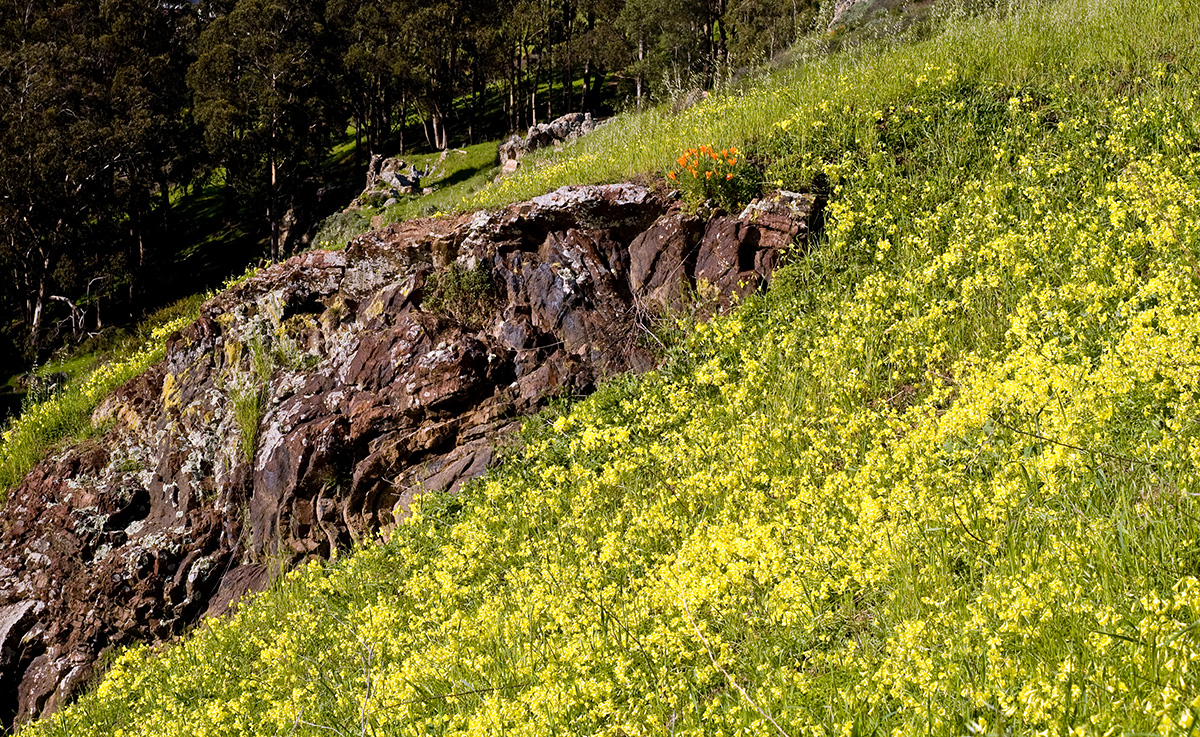
Sigg’s house, in San Francisco’s Sunset District, consists of four musty rooms. The foyer, living room, and kitchen all serve the same purpose: they are a library for Sigg’s interests, a testament to his voracious consumption of information. An upright piano, which has sat unused for many years, serves as a shelf for Sigg’s collection of ballet performance videos. The walls are a mosaic of awards, magazine clippings and pull-out posters—of Pinnacles National Park, the Rosette Nebula, shrubs of the coast ranges, wildflowers of the California coast. Field guides to native and invasive plants, including “The Jepson Manual,” a 1,500-page doorstop of a book, form three-foot high barricades on the striped green carpet.
“This is my war room,” Sigg said, as he led the way into a fourth room. “It’s where I pump out the propaganda.” He dragged a swivel chair across the floor, gestured for me to sit, and lifted the blinds on three large windows. To the west, the view was obscured by beige stucco. Outside the north facing window stood a two-story coast live oak—named so because, unlike most other deciduous oaks, live oaks are evergreen. The last window, facing east, framed Mount Sutro and Twin Peaks. Three maps depicting the flora and fauna of California and the San Francisco Peninsula before European arrival hung on the room’s lone wall.
For the last three decades, Sigg has authored “Nature News with Jake Sigg,” a weekly email newsletter on San Francisco’s parks and natural areas. The newsletter wanders between the topics that interest Sigg on a particular day—Chinese exclusion laws, San Francisco politics, poetry, overpopulation—but always, it comes back to the debate over non-native plants. Some days when he writes, he said, he will stand in front of the east window and gaze at the forest of eucalyptus on Mount Sutro.
“The tree huggers are the first to ask you for the science, yet they have none. Well, I don’t go by science because I don’t need to. I’m a gardener and I see what is happening. It’s right there in front of my eyes.”
Sigg slumped back into his chair and rested his hands on his belly. “Many people say that I want to remove all the eucalyptus,” he said. “I don’t mind a few of these eucalyptus remaining, but there’s a whole lot of, well, I don’t usually say this, but just for brevity I’ll call them tree huggers—I’m not trying to put them down, they just get very emotional about trees, is all—who believe that you don’t cut any tree, anywhere, anytime, for any reason. But there are times when trees have to be cut.”
Sigg paused, then he said, “The tree huggers are the first to ask you for the science, yet they have none. Well, I don’t go by science because I don’t need to. I’m a gardener and I see what is happening. It’s right there in front of my eyes.”
Sigg remembers the day he was called to gardening, almost 60 years ago. He was walking with his mother in Golden Gate Park and as they came over the top of a hill he saw the park’s Rhododendron Dell in full bloom. “Not a nanosecond elapsed between that sight and the realization that I wanted to be a gardener,” he said. That was a Sunday. On Monday, he walked into his job at Bank of America and quit. A year later, he started working at Golden Gate Park, and stayed there for 30 years, eventually becoming the head gardener at Strybing Arboretum. He knew each of the botanical garden’s 8,500 species by name. Before his philosophy on native plants had fully formed, he traveled the world—to China, Australia, and New Zealand—hunting for exotic species to expand the garden’s collections.
But in 1988, Sigg quarreled with the superintendent—his boss—who banished him to the southeast portion of the city to supervise the park district’s asteroid belt of athletic fields and playgrounds, where the job required about as much knowledge of botany as that of a car repairman. It was during this exile when he was walking in McLaren Park, a 318-acre parcel of native grassland near his office, and spotted a lone gorse growing among the wildflowers. He gripped the base of the shrub and ripped it out of the ground by the roots. Bits of wet soil showered down on him. He felt as if he had just cleared the entire West of the invasive plant. He had an epiphany.
“I just suddenly lost my interest in gardening. All I wanted to do was garden out there,” he said. He told me he felt sure that his true career, everything he has done for the last 30 years, began in that moment. “Here I thought the superintendent was a son of a bitch. But now I suspect he was a bodhisattva putting me on the path to enlightenment.”
On Sigg’s desk sat a 12-disk audio recording box set of “Herodotus: The Father of History” by Elizabeth Vandiver, Ph.D. Sigg told me he was listening to the lesson for the third time. Sigg is enamored with the ancient Greeks. Other books on ancient Greek civilization, ancient Greek literature, and famous ancient Greeks are strewn about his living room. With his silver beard trimmed to a spade, he even looks a bit like Burgess Meredith’s character, the wise poet Ammon, in the 1981 Greek mythological movie “The Clash of the Titans.” “We can learn a lot from the ancient Greeks,” Sigg said. “Rhetoric is one thing. Everybody who wanted to be anybody of influence had to study rhetoric. You needed to know how to sway people. And of course, Pericles was the greatest. He was a great orator.”
Sigg is the first to admit that, unlike Pericles, he is not a great orator, but he’s dedicated much of his life to perfecting his Socratic skills. In the early nineties, retired from his job at Golden Gate Park, Sigg found himself thrown into a debate over the removal of eucalyptus trees on Angel Island, in the northernmost part of the San Francisco Bay. The removal had moseyed along for four years until one day in July 1996, when a logging company clearcut 20 acres of trees in the south part of the island. Horrified hikers and tour guides wrote more than 260 letters condemning the removal to the San Francisco Chronicle alone. On the morning of July 12, 1996, Sigg defended the clearcutting on the NPR affiliate KQED’s talk show, “Forum.”
At one point, the show’s host, Michael Krasny, asked Sigg about the apparent paradox of removing a species in the name of biodiversity. “To some people this is a kind of environmental planning likened to perhaps social engineering,” Krasny said. “Talk about your perspective on it.”
Sigg, who seemed surprised that Krasny was asking a gardener non-sequiturs about politics, brushed the comment aside and, instead, gave an answer about what he knew best: plants. “What makes California different than any other place in the world?” Sigg asked. “It’s the plants and animals. There’s nothing like California anywhere in the world. There’s nothing like Angel Island anywhere in the world.”
But about halfway through the program, a man named Jim, from Inverness, called in and brought up the topic again, this time in a more direct way: “I hear an unfortunate echo in this argument of the argument against illegal aliens,” Jim said. “‘We have intruder species,’ ‘We have species taking resources from the native population.’”
Krasny threw the comment to Sigg.
“The race analogy, or whatever it was he was referring to, is not appropriate,” Sigg said. “This is a concept that…”
“Xenophobic against certain trees, as it were,” Krasny interjected.
“It’s a concept that some people set up in their mind. Then they react to the concept rather than to the real world,” Sigg said. “I think most educated people certainly agree that the cultural diversity we have in this country, especially in San Francisco, is something that enriches us, is something that we want to preserve.” But, he added, “if nothing is done, in time, there would be only one kind of plant on that island. It would be the Tasmanian blue gum.”
Back in his war room, Sigg got up from his chair and looked with fatherly devotion out the window at the large oak tree. “That tree is my teacher,” he said. He said he planted the oak from an acorn he picked up in Golden Gate Park in 1970 and has watched it grow. During the migratory season, he sits in the war room with a pair of binoculars and watches birds feed in the oak for hours. Based on Tallamy’s review, the coast live oak outside Sigg’s war room feeds some 275 different species of insects. From his desk, he pulled out on issue of Guardian Weekly and pointed at an article on “the great insect die off.” “Insects are crashing,” he said. “That is really, really bad news for birds.”
Sigg turned away from the oak tree and, with his hands on his hips, looked toward Mount Sutro. “That whole mountain over there should be covered in coast live oaks,” he said. “Right now, it’s not a forest. It’s a plantation. It’s a free-for-all. It’s just a mess. It’s chaos.”
There are cases of native insects eating non-native plants. In fact, some of the Bay Area’s most charismatic butterflies thrive on them: anise swallowtails on fennel, painted ladies on cheeseweed, skippers on lawns. Larvae of bay checkerspot, the butterfly Ehrlich famously studied, have been found munching on invasive English plantain.
The research documenting this trend is led by Arthur Shapiro, an expert on California butterflies at the University of California, Davis. I met Shapiro in early November at a pub on Davis’s main drag. He’s tall and wiry, with a long, tangled beard sprouting from a face that’s tanned and creased like old leather. When I arrived, he was standing at the bar, ordering a pitcher of Pabst Blue Ribbon, and throughout our interview he drank it like water. Throughout his 47 years at U.C. Davis, Shapiro has completed an exhaustive catalogue of the college town’s butterflies. He’s found that 13 of them feed almost exclusively on non-native plants.
In a recent debate that played out as a back-and forth in Sigg’s newsletter, Shapiro and Sigg sparred over the merits of invasive fennel. Shapiro made the case that fennel is so attractive to the anise swallowtail that most populations will not only readily accept it, but prefer it to their native host plants. What’s more, he wrote to Sigg that swallowtails rarely fly into a dense monoculture of fennel, but lay their eggs on individual plants at the margins, a phenomenon called “edge effect.”
“We need fennel if we’re going to keep the anise swallowtail in our local fauna,” Shapiro told me. “But, if you eradicate the stand and leave just one plant per acre, you’d actually be doing the butterfly a favor.”
“Wrong,” Sigg wrote back. He argued that keeping fennel as a singleton, or even a few plants, would require constant management.
“To wrap it up, Art,” Sigg wrote, “there is no such thing as one fennel plant in San Francisco or along the coast; you either have none or you have acres.”
“He’s a hardass,” Shapiro told me.
The basis for Shapiro’s hypothesis on how some native butterflies have come to use non-native plants is a process known as “ecological fitting,” which describe the way species without a shared evolutionary history, thrown together by accident, can click. It argues that the relationships between insects and their host plants are not a product of coevolution, but chance.
Shapiro has been teaching a course on community ecology at UC Davis for decades and one of his final exam questions is usually as follows: You are an ecologist visiting earth from a distant planet. You observe an apparent community on earth. There are plants. There are herbivores. There are carnivores. What observations could you make to determine whether the community is the product of a long line of coevolution or of short-term ecological fitting? “You know what the answer to the question is?” Shapiro asked. “Usually no observations.”
It’s so exceedingly rare, if it ever happens at all, that a restoration project becomes sustaining without continued human input
Shapiro likes to tell the story about how a friend of his, a nature educator and a dedicatee to one of his field guides to California butterflies, confided in Shapiro that he too had once been a native plant “Nazi.” One day, the man was leading a nature demonstration for public school children in San Francisco’s Bayview-Hunters Point neighborhood when one of them asked him: “If these immigrant plants are real bad does that mean we are real bad, too?” After that, the man told Shapiro, he began questioning his whole way of thinking.
“I’ve been troubled for a long time by the convergence of this language,” Shapiro said. “So I’m opposed, at a deeper, ideological level, to a blanket condemnation of so-called invasive species.”
Like Sigg, Shapiro is concerned about massive insect declines. But his work has convinced him that restoration ecology is not the answer to the problem. What’s more, he has said, it can siphon precious time and resources away from other environmental concerns, such as climate change. “It’s so exceedingly rare, if it ever happens at all, that a restoration project becomes sustaining without continued human input,” Shapiro said.
“It’s not science,” he added. “It’s gardening.”
Non-native. Immigrant. Alien. Part of the native plant movement’s public relations problem is that the words academia has long used to describe invasive species mirror the words used to describe people. But the native plant movement, indeed, conservation in general, has borne stains of racism since its inception. John Muir sought to force the Miwok Indians out of Yosemite Valley and lamented their tending of the landscape as “dirty and irregular.” The Manhattan aristocrats Madison Grant and Henry Fairfield Osborn co-founded the Save the Redwoods League in 1918 and, four years later, helped establish the American Eugenics Society. Grant’s pseudoscientific, white-supremacist book on the subject, The Passing of the Great Race, sported a dust jacket endorsement from none other than the monument president Theodore Roosevelt.
Among the book’s other admirers’ was Adolf Hitler, who wrote to Grant personally, calling the book “my bible.” The Nazis were obsessed with the purity of long-gone German landscapes. (Though, not all fascists shared this dedication—Benito Mussolini planted hundreds of acres of eucalyptus south of Rome in a mostly successful effort to drain swampland and reduce malaria.)
Conservation’s racist past has provided fodder against members of the native plant movement, who are frequently accused of being nativists and ecological xenophobes. In a 1994 essay in The New York Times Magazine, Michael Pollan, one of the country’s preeminent writers on gardening, dug up this history: “It’s hard to believe that there is nothing more than scientific concern about invasive species behind the current fashion for natural gardening and native plants in America—not when our national politics are rife with anxieties about immigration and isolationist sentiment. The garden isn’t the only corner of American culture where nativism is in flower just now.”
The frustrated native plant community often laments that such a hijacking of words steers the conversation away from grounded, firsthand knowledge toward a one-upmanship of rhetoric. But Sigg’s own politics do little to help this characterization.
“He is rabidly anti-immigration,” said McAllister, who has opposed restoration projects in the Bay Area for close to 20 years. “What, if any, relationship does this have to his similar commitment to native plants? I don’t know.”
Sigg is not shy about his anti-immigration politics. In his newsletter, he frequently writes about his opposition to immigration, both legal and illegal. In early November, Sigg stepped into the debate over birthright citizenship, which he also opposes. “My concern has never had anything to do with race,” Sigg told me. “It has only to do with the fact that this country is overpopulated.”
The overpopulation argument against immigration has its roots, most recently, in the Sierra Club, which for years stood by the position that more people equals more consumption, and more consumption threatens the country’s already fragile ecosystems. In 1989, the club’s board adopted a policy stating: “Immigration to the United States should be no greater than that which will permit achievement of population stabilization …” It reversed its position less than 10 years later.
Twice, club members organized as the “Sierrans for US Population Stabilization” fought to take over the club and reinstate its anti-immigration policy. One of the group’s most vocal members, John Tanton, who founded a Sierra Club chapter in Petoskey, Michigan (along with several anti-immigration and pro-eugenics organizations) has been labeled “the racist architect of the modern anti-immigration movement” by the Southern Poverty Law Center. In both cases, the group was narrowly defeated.
But the Sierra Club’s decades-long schism over immigration turned away millions of people who might otherwise have helped find solutions to some of the country’s most pressing environmental problems. “Even though it hasn’t been on the books for a long time, the Sierra Club paid a price,” said José Gonzalez, the founder and director emeritus of Latino Outdoors, an Oakland-based organization that seeks to increase Latino representation in conservation.
Regardless of what Sigg or others think, by 2050, the number of people in the United States will reach nearly 450 million, up from 300 million in 2005. It’s expected that more than 80 percent of that increase will be due to immigrants and their U.S.-born descendants. Conservationists who choose to view this new part of the population as a burden run the risk of ostracizing millions, making it unlikely the conservation victories of the 1960s and ‘70s will be replicable. “We won’t be able to have the same success in conservation with the same people we did [in the past],” Gonzalez said.
So, is there a place for an interest in native landscapes in today’s environmental movement? Gonzalez says yes. But only if people such as Sigg are able to move past a “my way, or the highway” mentality. To Gonzalez, the problem is absolutism: if it’s native it’s good, if it’s non-native it’s bad. Absolutism whether referring to plants or people or both tends to stymie the whole conversation. The debate over John Muir is the perfect example of this absolutism, Gonzalez said. People point out his racist and dismissive view of wilderness and others rise up to defend him. These groups have dug in to their partisan camps and rehashed the same arguments for decades.
“Muir is not here anymore,” Gonzalez said. But the environmental problems still are. He added: “We have to ask what our role is going to be moving forward?”

Sigg held up his mattock like a stop sign as he stepped onto O’Shaughnessy Boulevard, bringing the traffic to a halt. It was mid-April, and Sigg was leading a gardening sortie to the slopes of Glen Canyon. His goal was to remove invasive radish before they burst their seeds all over a particularly important meadow. Across the road, Sigg led the group down a small footpath hidden beneath the bows of a stout and spreading pine. The trail, worn into the canyonside, moved through a deep scrub of fragrant coyote bush, elderberry, and sage.
“Chew on this,” Sigg said. He handed me a sprig of sagebrush. Without a second thought, I put the young shoot in my mouth. It tasted not unlike soap. After waiting for Sigg’s nod of approval and seeing it would not come, I spit the sagebrush out. California sagebrush. Artemisia californica. Artemisia—the genus of plants that includes tarragon and absinthe—is defined by a universal bitterness.
“It’s named for Artemis, the Greek goddess of the hunt,” Sigg said. “When tricked into killing her companion Orion, she wept bitter tears.”
Eventually, the trail spit out onto a meadow colorful as an oriental rug—and only a bit larger. A relic of original San Francisco, the meadow was important because it supported a small population of central coast iris. Fluttering in a light breeze, the flower looked like a dark blue flame burning on the end of a long wick. It once grew wild throughout central California—and still does in some well-tended gardens. But on the San Francisco peninsula, this postage stamp of prairie was one of its last footholds.
“Look at radish hill,” Sigg said, motioning to a mound across the canyon where the battle had already been lost. “There is only one plant there—it’s radish.”
“Do you think it was a meadow like this before?” I asked.
“Well,” Sigg said. “The Natives burned this area constantly. If it weren’t for fire, we wouldn’t have any grasslands at all. The city used to burn every year around the Fourth of July, but stopped in the sixties.”
“And that’s never going to happen again,” I asked. “Right?”
“Well, yeah,” Sigg said, ripping a small clump of poison oak out of the ground with his bare hands. “The environmentalists put a stop to it!”
I sat back in the grass to take in the canyon. It was sunny and dry. The perfume of the sage was almost cloying. The meadow was surrounded on all sides by poison oak and Himalayan blackberry that blanketed the rest of the hillside. Getting rid of all of it seemed an almost Sisyphean task.
Sigg kept weeding.


